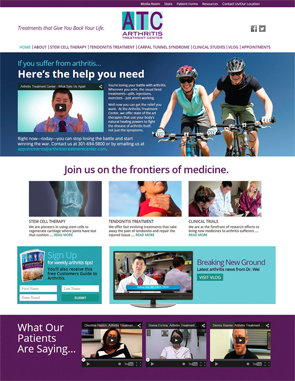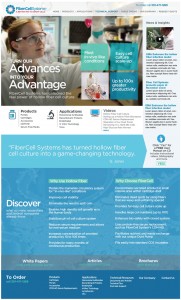
Image Credit: alphaspirit/shutterstock.com
A website provides visitors with a first glimpse of your practice. “Whether you like it or not, people will learn about you and judge you based on your website,” says David Borenstein, MD, MACR, MACP, rheumatologist and partner, Arthritis and Rheumatism Associates, and clinical professor of medicine, Division of Rheumatology, Department of Medicine, The George Washington University Medical Center, Washington, D.C. Use a website to put your best foot forward and set yourself apart from other practices.
A website also contributes to a practice’s credibility. “Potential patients expect professional practices to have a website—and an impressive website at that—and can be wary of practices that do not have at least a basic online presence,” says Gwendolyn Gainer, founder and creative director, Teramark LLC, Frederick and Bethesda, Md.

Ms. Gainer
After all, we now live in a digital age. “Many patients no longer search the Yellow Pages, they go straight to the Internet to find a practice,” says Justin Peng, MD, also a rheumatologist and partner at Arthritis & Rheumatism Associates. In particular, they want to obtain information regarding a physician’s credentials, services, locations and accepted insurances, as well as trustworthy educational and evidence-based information.
Focus on Design Elements
When designing a website, all of the design elements should work seamlessly with the content to take the user’s eye to key messages, Ms. Gainer says. Layouts should avoid clutter, allowing breathing room for clear messaging and imagery.
Choose color palettes carefully, because they can offer insight into a practice’s personality. “Blue is commonly used for healthcare practices, especially for specialists that tend to be more on the conservative side,” says Brenda Brouillette, RN, BS, a consultant with Savvy Marketing Solution and a business development specialist who creates website content and manages digital marketing for Arthritis & Rheumatism Associates in the Washington, D.C., metro area. “Blue represents loyalty, trust and security.”
Use a variety of color tones to provide contrasting vibrancy, but never use more than five different colors in the website palette, advises Ms. Brouillette. “Leave enough white space to allow for effective color design components that are not overbearing,” she continues. “Pages that are too busy are overwhelming and can mask a page’s messages.”

The Child Neurology Foundation focuses on its advocacy, research and educational initiatives, using images of happy children on its website to support its message and create a sense of empathy: http://www.childneurologyfoundation.org.
Website designed by Teramark

Dr. Borenstein
Make pages easy to navigate by labeling menu tabs and avoiding lengthy paragraphs that aren’t easy to scan. The Web is a visual entity, Dr. Borenstein points out. “You can’t write War and Peace. Keep content to one page, because readers tend to read one page at most.”
Use a large enough font size that adjusts to a screen’s size, such as 16 pixels; a font style that is easy to scan, such as Garamond, Veranda, Tahoma or Palatino; bullet points; and other tools to help consumers navigate content. Headers will aid readers in understanding each section’s main message.

Ms. Brouillette
Photos enhance a website. “The old saying, ‘a picture is worth a thousand words,’ is true,” Ms. Brouillette says. “Include photos of physicians to show that they care and are open, which begins the trust process.”
A website needs to be part of a larger Web marketing campaign. Web analytics & search engine optimization work hand in hand.
Nathan Wei, MD, FACP, FACR, practice owner and rheumatologist, Arthritis Treatment Center, Frederick, Md., advises using photos of active people and the practice in motion. “Use photos that offer hope; avoid ones that are depressing,” he says. His website contains commercial stock photography, as well as photos of his practice.
Dr. Wei also strongly recommends using video clips. “Having someone see what you look like and hear how you sound is important—it conveys a sense of authority and expertise,” he says. “It also gives you the opportunity to educate and sell yourself.”

Dr. Wei
Taking this a step further, Dr. Wei advises allowing viewers to comment on videos. He promptly answers any posed questions. Again, this creates a sense of authority and expertise.
Like videos, surveys offer an interactive and engaging element. “This is a simple way to get people to participate and share valuable information about their practice experience,” Dr. Wei says.
Developing Content
As you begin to create website content, first list all keywords and phrases that are relevant to your practice, Ms. Brouillette advises. Content throughout your website should consistently use these keywords. This helps Google, Bing, Yahoo and other search engines increase the number of visitors to a website by obtaining a high-ranking placement on the search-results page—a methodology called search engine optimization.
Above all, messaging needs to address website visitors—their needs, desires and concerns. “You want visitors to visualize themselves as needing your services and benefiting from them,” says Ms. Gainer, who designed Arthritis Treatment Center’s website. “Therefore, don’t infuse messaging with self-aggrandizing content that is irrelevant. If the visitor feels your message is all about you and not about them, then they will likely perceive your website as just transparent marketing.”
Messaging should immediately suggest what is distinctive about a practice. “Just listing services that are common to practices like yours won’t set you apart in a visitor’s mind,” Ms. Gainer notes.
The Home Page

Dr. Peng
The home page—a visitor’s first view of your website—should include your practice’s logo, mission statement and photos that depict what the practice is about. Include a photo of each rheumatologist and buttons that link to frequently sought-after information, Dr. Peng suggests.
Try to limit the menu bar to no more than seven categories. A dropdown menu of subpages allows readers to know what types of information is provided, Ms. Brouillette says, so titles should reflect each page’s content.
“The key is to make it very user friendly, with contact information and patient portal access readily visible,” Dr. Peng says.
Video introductions from each rheumatologist will help start a connection. “Having the physician briefly explain why he [or she] is in practice or why he [or she] made the decision to enter the medical field is a great way for the reader to relate to the physician on a more personal level,” Ms. Brouillette says.
Dr. Wei’s home page contains an introductory video, in which he shares why he pursued the field of rheumatology. Simply put, he has a sister with rheumatoid arthritis and a son with juvenile arthritis. He set his mind on eradicating these diseases.
About the Practice Page
Each rheumatologist should have a biography that includes where they received their education, as well as academic information, credentials, experience and special interests. Use this section to humanize physicians. Don’t hesitate to add a biographical detail or two that may help a potential patient connect with them, Ms. Gainer says. Patients want to be comfortable with their physician and the expertise they represent.
Similarly, if there is a story behind the founding of the practice—one that underscores a sense of dedication or mission—include that as part of the practice’s narrative.
Services & Treatments Page
Give particular attention to services that you want to grow a patient base around. But also keep in mind the services that your patients clearly want and will pay for most readily, Ms. Gainer says. In other words, understand the reasons that patients naturally come to you—and keep that engine going while cultivating the new patient base.
Simply providing a list of services or treatments is not enough, however. Including descriptions and explanations is key. Use photos and educational videos to explain a procedure. Offer a library of conditions to help build you as a thought leader in your specialty. If your practice has a narrow focus, be sure to convey that.
Also list any services you offer, such as laboratory testing, radiology testing, infusion services, the use of biologics, physical therapy, diagnostic testing and clinical research.
In the News Page
This page shares a physician’s accomplishments, their commitment to community outreach and, again, their role as a thought leader in their specialty. Be sure to list any speaking engagements in both the medical arena and the general community, and include videos of interviews, printed news articles and any other media highlights. Organize these accolades into categories.
Make the news section as useful to the visitor as possible. “Too many practices fill up their news section with self-serving fluff, such as press releases about every single event or development within the practice,” Ms. Gainer says. Use this section to highlight important developments that have real ramifications for your patients. Consider having a section in which you post articles related to your practice’s specialty areas so that you apprise visitors of new and fascinating developments in your field.
And don’t forget to keep content current with the latest information. Having your most recent news item be dated a year ago is a turnoff.
Testimonials Page
Patient stories are the best endorsement and component of building your reputation. They can be written quotes or an actual video that provides an honest, believable recommendation.
To obtain testimonials, Dr. Wei targets patients who offer a compliment or sincere thanks. “Ask if the patient would mind sharing their comment with others,” he suggests. “If agreeable, have them sign a waiver and grant permission to use their full name and town of residence. Nothing is less credible than seeing a testimonial from ‘Donna P.’”
Ideally, testimonials and patient stories will reveal something insightful about your practice. “It’s especially smart to focus on your competitive advantages (i.e., the distinctive qualities that appear in your homepage messaging) and have your testimonials reinforce these to your website visitors,” Ms. Gainer says.

The Arthritis Treatment Center website
(http://arthritistreatmentcenter.com) contains commercial
stock photography, as well as photos of the practice.
Website designed by Teramark
Patient Forms Page
Cultivate goodwill by providing patient forms online. Any forms that patients can fill out before they arrive at your office will make their visit more efficient and pleasant, Ms. Gainer says.
If an office has the ability to preregister a new patient prior to an appointment by accessing an electronic medical record patient portal, this is an ideal way to transport the information to a secure system and upload it without printing any forms.
Ms. Brouillette also recommends posting a practice’s medical records policy, medication refills policy, HIPAA policy, insurance and payment information, and patient portal information online. Consider offering online scheduling, which is growing in popularity because consumers like the immediate gratification of scheduling their appointment, Ms. Brouillette says.
Contact Information Page
Prominently include contact information so interested patients can easily get in touch with you. List your telephone number, fax number, e-mail address and physical address. Provide an interactive map, such as Google Maps, as well as a photo of the practice’s building or lobby.
Selecting a Website Designer
When looking for someone to design your website, Dr. Borenstein advises choosing a firm that is experienced in the medical sphere. The designer should be able to create a fresh and vibrant look, know how much space is needed and use engaging language that readers with a 10th-grade education can comprehend.
Use a website to set yourself apart from other practices
Cast a wide net. Dr. Wei asked his assistant to get referrals and find some visually pleasing websites. Ultimately, he considered seven different Web developers. He reviewed their work and spoke with previous clients about their experience.

Consider your color palette. We typically associate red with anger, pink with love and magenta with harmony. Blue, as used on the Fiber Cell Systems website (http://www.fibercellsystems.com), is the color of trust and peace, and can suggest loyalty, integrity and conservatism. Green is the color of balance and growth, and it can mean self-reliance, among many other things. Color is one way to subtly encourage your patients and site visitors to trust you.
Website designed by Teramark
Have a Social Media Presence
Expand your Internet presence to social media websites. “This will help get your name out, enhance your authoritative status and allow for interaction,” Dr. Wei says. “Visitors can ask you questions on Facebook and follow you on Twitter. Although these followers may not become patients themselves, they could refer a relative or friend who lives nearby.”
In addition to garnering patients, social media can be a powerful way to educate the public. “People are hungry for reliable healthcare information and are increasingly looking to social media,” Dr. Peng says. “In the evolving field of rheumatology, it’s important for us to stay current with the times and provide reliable healthcare education through these avenues as well.” Social media can also enhance your practice’s visibility online and increase search engine optimization. As a result, Web browsers can more easily find your website and will view it as a trusted resource.
Dr. Peng’s practice has a presence on Facebook, Twitter, Google+ and LinkedIn. On Facebook, it posts educational healthcare content from trusted resources, such as the American College of Rheumatology and the Arthritis Foundation. It also posts articles written by its physicians, and has started a blog about various rheumatologic conditions. “We try to keep our patients up to date regarding the logistics of the practice, wellness classes, as well as surrounding healthcare events, such as the Lupus Walk or the Walk to Cure Arthritis,” Dr. Peng says.
Dr. Wei has posted almost 2,000 videos on YouTube, which he promotes on Twitter. On Facebook, he posts daily tips for people with arthritis. “I write tips, glean them from magazines or pharmaceutical companies and get them from patients.” Visitors to the practice’s website can sign up to be e-mailed a daily tip.
Dr. Borenstein uses Facebook and Twitter to promote his weekly radio program that includes a podcast with one-minute vignettes.
Beyond a Website
Taking things a step further, a website needs to be part of a larger Web marketing campaign. Web analytics—the measurement, collection, analysis and reporting of Web data—and search engine optimization work hand in hand. “You won’t know if your website is providing the right traffic or converting visitors without analytics,” Ms. Gainer says. “Use search engine optimization to tweak your website based on those findings.”
“I never thought when I went to medical school that I would be judged by my presence on the Internet,” Dr. Borenstein quips. “It has been an eye-opening experience. But this is our current day and age. You can either fight it or embrace it. Whether doctors like it or not, patients will go to the Web. If you want to reach people and educate them, the Web is the way to potentially reach the world.”
Karen Appold is a medical writer in Pennsylvania.

Image Credit: Rawpixel/shutterstock.com
10 Website Design Tips
- Choose color palettes carefully (think about the emotions colors convey), and avoid using more than five colors on your site.
- Select easy-to-read fonts in a large enough size to scan quickly.
- Label menu tabs clearly; anticipate how patients will look for information.
- Introduce your physicians and staff; include bios, photos, videos.
- Use photos of your physicians positively interacting with patients.
- Post downloadable documents that new patients will need to complete prior to their first visit.
- Make your site interactive; include surveys and a way for patients to ask questions and make appointments.
- Make it educational; include disease fact sheets and relevant research, links to support groups and other information patients might find valuable.
- Tell your practice’s story—what makes it unique.
- Tell your patients’ stories (with permission and signed waivers), and let them recommend you.


